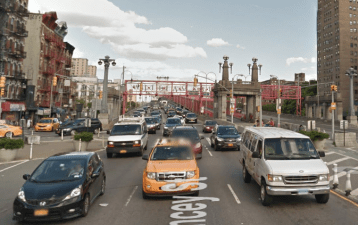Mayor de Blasio Needs to Step Up to Keep L Train Passengers Moving
This morning the MTA announced that starting in 2019, it will close the L train between Eighth Avenue and Bedford Avenue in Williamsburg for 18 months to repair damage caused by Superstorm Sandy — surprising no one who’s been paying attention.

For several months now, it’s been obvious that the MTA and the de Blasio administration will have to work together on a plan to keep hundreds of thousands of L train passengers moving during these repairs. The MTA will have to adjust subway service and run more buses, and the city will have to allocate space on the streets for high-capacity busways and safe bicycling.
But in a statement to the Times, Deputy Mayor Anthony Shorris framed the shutdown as a problem of the MTA’s own making:
We are deeply concerned that it would announce an 18-month shutdown of this critical service without a clear plan or a commitment of resources for mitigating the impact of this closure on hundreds of thousands of New Yorkers. Well before this shutdown occurs, New Yorkers deserve clarity from the M.T.A. on how it intends to minimize inconvenience and keep people moving throughout the duration of the construction.
And when Mayor de Blasio addressed the L train shutdown this morning, he didn’t stray from that message:
So, we’re looking at that very seriously. First of all, I’ll remind everyone the MTA is run by the State of New York. The amount of time that they have projected — the 18 months — is a very big concern for me and for the City government. We’re going to have some very serious conversations about the MTA, about whether it has to take that long and how it’s going to be handled. I want to make sure there’s a lot of redundancy in place. By the time it happens, one — small but important factors — we’ll have the citywide ferry service in place, so that’ll be helpful, but we’re going to need a lot more than that, obviously. So I want to press the MTA to show us that 300,000 riders really will have good and consistent alternatives. And we’re certainly going to look at what we have to do in terms of the bridge as part of that. We’ll have an answer on that after those discussions with the MTA.
Noticeably absent from de Blasio’s statement is a specific mention of buses and bikes as “redundancy” measures. Ferries can help, but setting aside street space to move large numbers of bus passengers and bike riders will do more to make up for the loss of L train service.
It’s up to the MTA to run additional bus service, but it’s up to de Blasio, Shorris, and DOT Commissioner Polly Trottenberg to redesign streets. Without their leadership, they’re won’t be a car-free PeopleWay on 14th Street that L train passengers can turn to. They’re won’t be bus lanes and bike lanes linking Williamsburg to the Lower East Side.
Other elected officials are on board. City Council transportation chair Ydanis Rodriguez expressed support for the “PeopleWay” in a statement this afternoon, and other Manhattan elected officials, including Manhattan Borough President Gale Brewer, are open to the concept. Brooklyn Borough President Eric Adams has called for dedicated bus lanes on the Williamsburg Bridge during the shutdown.
L train riders need leadership from de Blasio and Governor Cuomo while service is disrupted. If it becomes just another occasion to point fingers, everyone loses.

